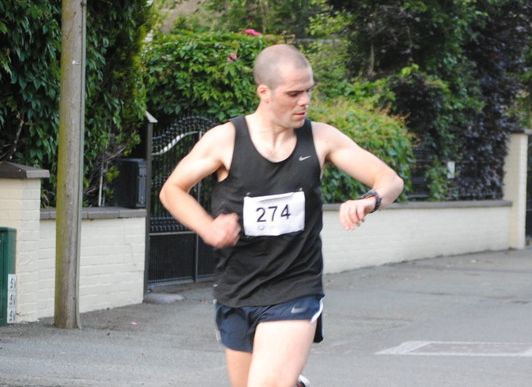
Modern watches are amazing devices, measuring distance more accurately all the time, not to mention all the other amazing things they measure with ever increasing accuracy.
However, if you’ve ever relied on your watch on race day, you know it lies. Why and what should we do about it?
Technically, unless you’re around a lot of tall buildings or similar GPS obstacles, it’s not really lying. It’s measuring with pretty good accuracy how far you’ve run. The problem is, on race day, you almost certainly didn’t run the advertised distance of the race.
Why? Because courses need to be measured taking the shortest possible distance and you are almost certainly not running the shortest possible distance. You probably didn’t run perfect tangents throughout the course. You probably didn’t stay right on the very inside of every turn. You probably had to swing wide or even weave around a bit to go around other runners. You might have even swung wide on a sharp turn in order to keep your momentum going. Every time you do something like this, you’re adding distance.
This is why it’s common to see runners say after a marathon that the course was long, their watch measured 26.8 miles. Or after a 5K, they might say they ran 3.3 miles. They aren’t wrong about how far they ran but they are wrong about the distance of the course. Of course, that is unless the course is actually long, which happens sometimes but very infrequently at major events and well run smaller events.
So, what are you to do if you have to run farther than the actual distance of the race? Well, if you have a time goal, you better adjust, both on race day and in your preparation.
On race day, if you have a specific time goal and have a pace plan to get there, I strongly recommend you don’t rely too much on your watch’s mile splits. Rely on the mile splits on the course. They are more likely to be technically accurate according to the actual distance of the course.
In your preparation, if you have goal race pace workouts, you should be adjusting for the fact that you’re going to run a little longer than the advertised/actual distance of the race. Look at your prior races and see how much longer you typically go. Then adjust accordingly.
If you’re new to racing, most runners go about 2-5% longer than the actual race distance, depending on factors like number of turns (more turns means more opportunity to add distance) and crowd size (more runners means it’s harder to run the tangents). Pick a number somewhere in this range and plan for that.
Whatever you do, be careful to not trust your watch to measure your next marathon as exactly 26.22 miles or your next 5K as exactly 3.11 miles. If you do so, you just might find yourself meeting your goal on your watch but not at the finish line.

> You probably didn’t run perfect tangents throughout the course. You probably didn’t stay right on the very inside of every turn. You probably had to swing wide or even weave around a bit to go around other runners. … This is why it’s common to see runners say after a marathon that the course was long, their watch measured 26.8 miles”
This is incorrect. The reason GPS reports a longer distance is because GPS has limited accuracy, especially with tiny receivers that fit in a running watch, and relies on smoothening algorithms. It has nothing to do with “not running tangents” or “weaving around other runners” – this effect is negligible. Nobody runs 26.8 miles in a marathon. All you have to do is zoom in on your Strava or Garmin Connect map after the race and you can see where GPS inaccuracies went off course and added distance. Sometimes, GPS inaccuracies can even subtract distance (by cutting corners) leading to a shorter overall distance, but this is less common.
All the evidence I’ve seen says otherwise. People who are running good tangents at smaller races can come very close to the listed race distance. Sometimes over, sometimes under. People who are running in packs can go up to 5% longer than the listed race distance. GPS inaccuracies are a factor but not always in the same direction. Running in crowds definitely leaves you running longer than the listed race distance, sometimes by somewhat significant amounts.
Regardless, though, the point that you can’t rely on your GPS device stands. Whatever the reason is, you will likely not finish with your GPS device reporting the actual distance of the race.